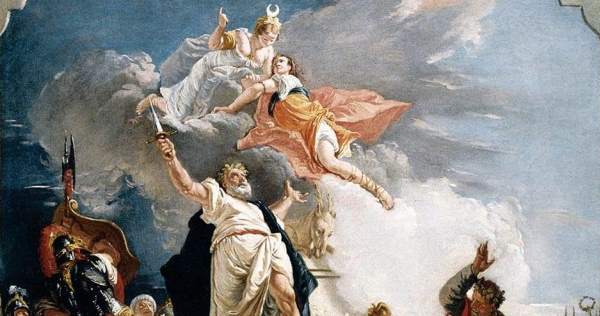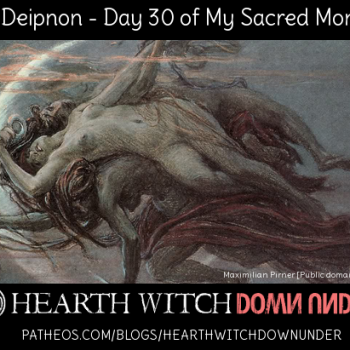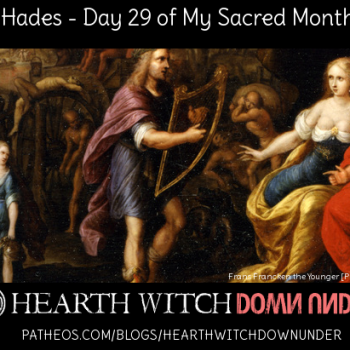In my last post we looked at an origin myth of Hekate in which she was actually a human princess of the Tauri. In this post we are going to look at another myth about Hekate, the one where She begins life as the very human Iphigenia.
Iphigenia was the daughter of King Agamemnon and Queen Clytemnestra and her story begins during the Trojan war.

Iphigenia
“But when they had put to sea from Argos and arrived for the second time at Aulis, the fleet was wind-bound, and Calchas said that they could not sail unless the fairest of Agamemnon’s daughters were presented as a sacrifice to Artemis ; for the goddess was angry with Agamemnon, both because, on shooting a deer, he had said, “Artemis herself could not (do it better),” and because Atreus had not sacrificed to her the golden lamb. On receipt of this oracle, Agamemnon sent Ulysses and Talthybius to Clytaemnestra and asked for Iphigenia, alleging a promise of his to give her to Achilles to wife in reward for his military service.” – The Library, Apollodorus.
One day, as some of the stories put it, Agamemnon was hunting and afterwards boasted that he was better at hunting than Artemis Herself. This of course angered the Goddess and She decided to punish him by not allowing his fleet to move at all. Divination revealed the only way to appease Artemis was to sacrifice one of Agamemnons daughters.
Agamemnon decides on Iphigenia (in some stories Iphigenia is specified in the divination) and sends Odysseus (or goes himself) to Clytemnestra with a concocted story to convince her to send Iphigenia to him. The story told is that Iphigenia will be given to Achilles as a reward for his military service. Clytemnestra agrees and sends her daughter along.
In Iphigenia at Aulis, she begins her part in the story as quite the innocent and naïve child. Of course this is precisely what makes her so suitable for the sacrifice, a young maiden who knows little of the world outside of her own childs eye perception. In some versions of the story she doesn’t realise she is to be sacrificed until the very end, but in others she learns of the ruse. When she first discovers her true purpose for being called on by her father she begs for it to not happen, for it is better to live a dishonourable life than to die.
The Sacrifice of Iphigenia
“If Artemis wishes to take my body, will I, a mortal, stand in the way of a goddess? No! Impossible! I give my body to Greece. Make the sacrifice! Eradicate Troy! For a long time to come that will be my monument, my children, my marriage, my fame!” – Iphigenia at Aulis, Euripides
But in the lead up to the sacrifice Iphigenia becomes a different person entirely. While listening to her mother and Achilles talk about how they want to stop the sacrifice, she suddenly changes her tune. In moments she goes from wilful scared child to a young woman willing to give all she can give for the sake of her father, her family and her people. She goes to the sacrifice willingly. Her reasons are many, to save her family, to help her people win the war, to destroy Troy, to honour and obey the Gods and because, in her words, men are far more important than women so how can she put her life above the lives of her father and his army.
There are a few different versions of what happens during the sacrifice. In some Agamemnon attends the sacrifice himself, but in others it is his men who perform the sacrifice and come to tell him about it afterwards. But the biggest difference is the end result. Of course in some of the stories Iphigenia is simply sacrificed, all goes well and the army is able to go to Troy.
But in other versions, such as in Hyginus’ Fabulae and Euripides Iphigenia at Aulis, she is about to be sacrificed when suddenly Artemis appears and snatches her away. In her place Artemis leaves a deer or calf to be slaughtered instead. She is then taken to Tauric Chersonese to become a priestess to Artemis and perform sacrifices of strangers to the Goddess there. Her story continues for much longer.
Iphigenia the Goddess
“When the expedition had mustered a second time at Aulis, Agamemnon, while at the chase, shot a stag and boasted that he surpassed even Artemis. At this the goddess was so angry that she sent stormy winds and prevented them from sailing. Calchas then told them of the anger of the goddess and bade them sacrifice Iphigeneia to Artemis. This they attempt to do, sending to fetch Iphigeneia as though for marriage with Achilles. Artemis, however, snatched her away and transported her to the Tauri, making her immortal, and putting a stag in place of the girl upon the altar.” – Cypria, fragment 1.
“So Clytaemnestra sent her, and Agamemnon set her beside the altar, and was about to slaughter her, when Artemis carried her off to the Taurians and appointed her to be her priestess, substituting a deer for her at the altar ; but some say that Artemis made her immortal.” – Apollodorus, The Library
“Artemis made a bull calf appear by the altar instead of Iphigenia whom she carried off far away from Greece, to the Sea of Pontus with its welcoming name of Euxine, to Thoas son of Borysthenes. She called the tribe of nomads there Taurians because a bull had appeared instead of Iphigenia on the altar. She also named her Tauropolos. After the passage of time, Artemis transferred Iphigenia to what is called the White Island to be with Achilles and changed her into an ageless immortal deity, calling Her Orsilochia instead of Iphigenia. She became the companion of Achilles.” – Antonius Liberalis, Metamorphases.
How Iphigenia becomes a Goddess is not really discussed in many of the myths, other than that it is Artemis who is responsible for her deification. As we can see in one of the fragments we have of Cypria, and the mention in The Library, how and when she becomes immortal is not really expounded upon. It’s mostly mentioned as though in passing.
But we do know the virgin Goddess worshipped by the Tauri, while sometimes named Artemis, is other times identified as Iphigenia. Sometimes Iphigenia is nothing more than an epithet for Artemis, which leads some people, like Carl Kerenyi, to believe that Iphigenia was the original Greek virgin Huntress of people like the Tauri and was conflated with and eventually subsumed by Artemis. And it is important to remember that when writing about places they didn’t live in or had never been to, it was common for ancient writers to use the name of a common Hellenic deity to make an unknown similar foreign deity more recognisable.
So it is possible that the story of Iphigenia arose out of the need to explain the existence of an unknown Goddess of a certain region. With no origin story of her own in the classic lore, the need arises to find a feasible origin for Her that fits well enough with the already existing lore. And so, an unknown Goddess named Iphigenia is created by Artemis, to be much like Artemis. The idea of Iphigenia being the Goddess in certain areas before Artemis took Her place is also implied by Pausanias.
“There is also a temple of Artemis, with an image in the style of art of the present day. The priesthood is held by a virgin till she attains a marriageable age. Here, too, stands an ancient image : the inhabitants say it represents Iphigenia, daughter of Agamemnon. If they are right, the temple must clearly have been made originally for Iphigenia.” – Pausanias, Description of Greece, Aegira, XXVI.
Iphigenia and Hekate
“I heard another story of Iphigenia told by the Arcadians, and I know that Hesiod in his Catalogue of Women says that Iphigenia did not die, but became Hecate by the will of Artemis. In harmony with this account, Herodotus writes that the Taurians on the borders of Scythia sacrifice castaways to a virgin, and say the virgin is Iphigenia, daughter of Agamemnon.” – Pausanias, Description of Greece, Megara, XLIII.
But this is where things get tricky. While we can easily see the reason for and believe the stories of Iphigenia becoming a Goddess, there is more to it than that. In a few versions Iphigenia didn’t just become a Goddess in Her own right, nor did She become merely an epithet of Artemis. In some stories Iphigenia is turned, by Artemis, into a Goddess named Hekate.
Unfortunately for us the most original text that we know of to contain this account, no longer exists. All we have is a small fragment, not even a fragment, just a small mention by Pausanias that he knew of or read about it in Hesiods now lost Catalogue of Women. There is also one other fragment, which is actually a mention of a mention of Hesiods Catalogue.
“Stesichorus in the Oresteia follows Hesiod in identifying Iphigeneia daughter of Agamemnon with her whom we now call Hecate.” – Philodemus, Piety (discussing Stesichorus, Oresteia, which is also lost), trans J.M. Edmonds.
And so we have at least two versions of the myth of Iphigenia where she is turned into Hekate, and both of them – Catalogue of Women and Oresteia – are unfortunately lost to time and only exist through mentions and quotes by other writers. This makes it extremely difficult to really get into this myth, to explore it and figure it out.
Without the original myths it is difficult to discuss what this might be all about, how this origin of Hekate can fit with the already well-established origins that we have. How can a Titaness, born of Titans, older than the Gods of Olympus and much respected and honoured by those younger Gods suddenly be a deified human? And then just looking at how vastly different Iphigenia is to the Goddess Hekate, well it’s a difficult one to parse to be honest.
Hekate, Artemis, Iphigenia and the Tauri
It is odd that the two myths regarding Hekate being human seem to involve and/or revolve around Tauris. In the one she is a human Princess, daughter of the king of Tauric Chersonese. In the other she is the defied Iphigenia, who was priestess to Artemis in Tauris. So it all seems to come back to Tauris.
It’s possible this is all nothing more than an attempt to explain how three different Goddesses ended up being worshipped by a people who clearly only worshipped one Goddess. We have a foreign Goddess the early Greeks named Iphigenia being worshipped, some people name Her Artemis because, conflation, and lots of people name Artemis, Hekate. To reconcile these three we have one of Them turn another of Them into the third one. Voila! All fixed up.
But it also doesn’t really work out. It still doesn’t mesh with Hekates usual origin story. And without the original texts, the full stories about Iphigenia turning into Hekate, this isn’t something I can really explore much further. It’s one thing to have conflation between the three Goddesses, but it’s quite another to completely change a Titaness’ origin story in such a monumental way. It doesn’t fit, and it doesn’t make much sense at all.
But I think it must come back to the Tauri, there is something about that place and those people. That this place is a focus for both of Her human origin stories is telling. I just don’t know what it is telling. Maybe I have it backwards, for all we know Hekate could have originated in Tauris and was subsequently subsumed by Iphigenia and then Artemis. We still don’t know for sure where Hekates cultus originated, Tauris is not an impossibility.
















